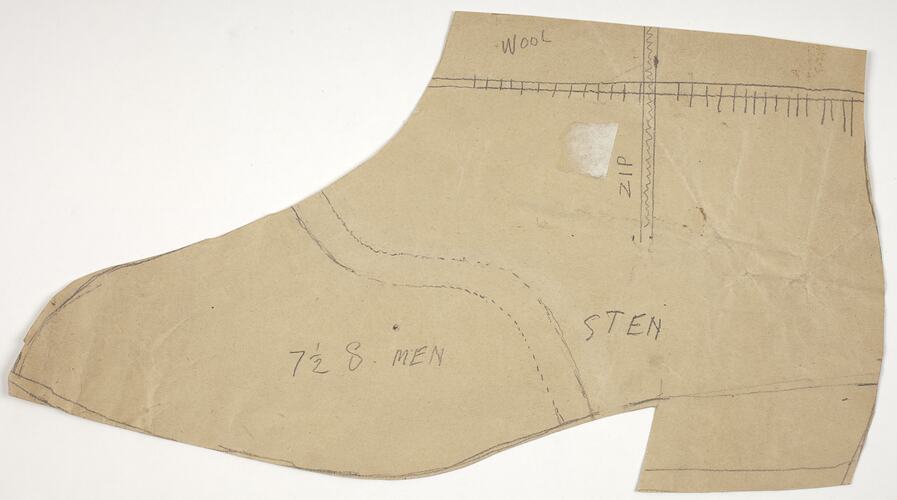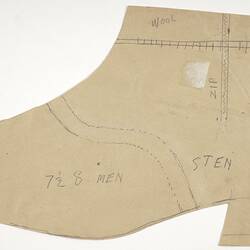Summary
Hand-cut men's ankle boot pattern created from brown paper. The combination of the pattern's markings indicating different construction mediums such as wool, decoration, zip and sizing, and the centrally located word 'STEN' suggests this to be a particular style. Amongst many others, this pattern is part of the shoemaking designer kit that enabled Stanio Fancoff to acquire versatility and different fashions within his shoemaking trade from the 1930s to the1970s.
Stanio Ivanoff Fancoff was born in 1908 in Bojentsi, a small village in Bulgaria. At age 11, Stanio left home to learn the shoemaking trade. In 1929, he immigrated to Melbourne, settled in Fitzroy and began to work for the V.G. Zemancheff & Sons basket shoe factory in South Melbourne. In1936, he married Dorotea Georgi Touzou who had recently arrived in Australia. Around this time, Stanio set up his own shoemaking business from home, with Georgi, her cousin and sister weaving the shoes which he then assembled. Select shoe samples were then taken to Sydney and Tasmania for sale. In 1942, Georgi and Stanio moved to Broken Hill for Georgi's health; there daughter Nancy was born and Stanio set up a shoe shop/factory. In 1945, Georgi died and by 1950 Stanio and Nancy had moved to Adelaide where he again opened a shoemaking business and shop. He passed away in 1978, having been in the shoemaking business for 59 years. This collection documents his migration and working life experiences.
Physical Description
Created within a side-view perspective, this brown paper boot pattern indicates materials, decorations and sizing to locate this pattern within the genre of men's fashion. Paralleling the sole's base at approximately a 2mm inset is a single pencil line. The 3.5cm heel has a penciled line that parallels its sole's baseline, possibly indicating that the designer changed and extended the original design's heel height. Descending from the upper is an double-lined elongated 'S' shape that ends at the boot's shank. Located approximately 2.5cm from the top line are two horizontal lines with twenty-nine small vertical lines and the word 'wool' written in this top area. Centrally located within the boot's ankle section are two vertical lines with a centralized zig-zag and the term "ZIP" appearing adjacent. Directly below the 'Zip indicator is the term 'STEN', and the sizings of "7 1/2 8. MEN" is written within the vamp section. While the pattern's paper appears in good condition, it does exhibit several crease marks above the heel section and a white square paper patch measuring approximately 2 x 2cm adheres to the upper central area.
Significance
This collection is significant in documenting a small migrant business as well as the fashion of a particular period. It is well provenanced and charts the application of trade skills in a new country. It also illustrates the stages of hand shoe manufacture from the 1930s, demonstrating the enduring nature of the tools and patterns that were used.
More Information
-
Collecting Areas
-
Acquisition Information
Donation from Nancy Vasileff, 21 Mar 2007
-
Maker
-
Inscriptions
Text: WOOL / ZIP / 7 1/2 8. MEN / STEN
-
Classification
-
Category
-
Discipline
-
Type of item
-
Overall Dimensions
320 mm (Width), 167 mm (Height)
-
References
R.A. Salaman, 'Dictionary of Leather-working Tools c.1700-1950 and Tools of Allied Trades,' London: George Allen and Unwin (Publishers) Ltd, 1986 [Section 2: Boot and Shoe Maker pp18-185]. John Peacock. 'Shoes, The Complete Sourcebook,' London:Thames & Hudson Ltd, 2005. NAA holds file (online) on Vasil George Zemancheff, Fancoff's employer
-
Keywords
Boot & Shoemaking, Bulgarian Communities, Bulgarian Immigration, Immigration, Small Businesses



